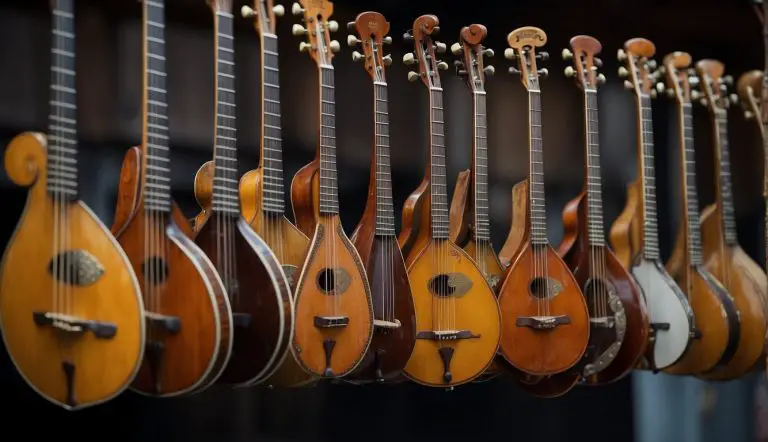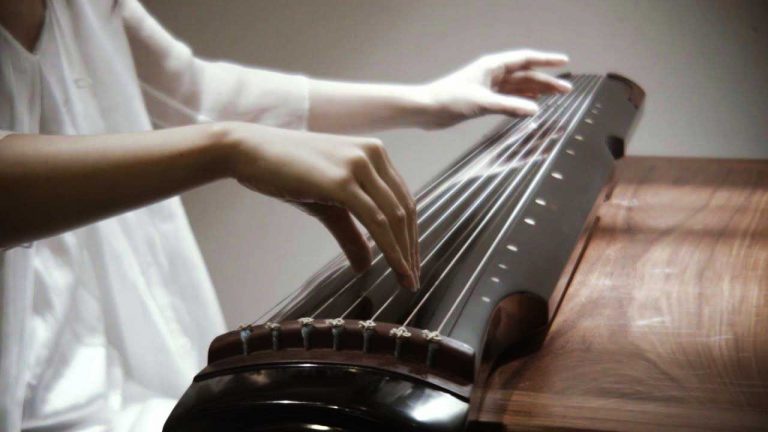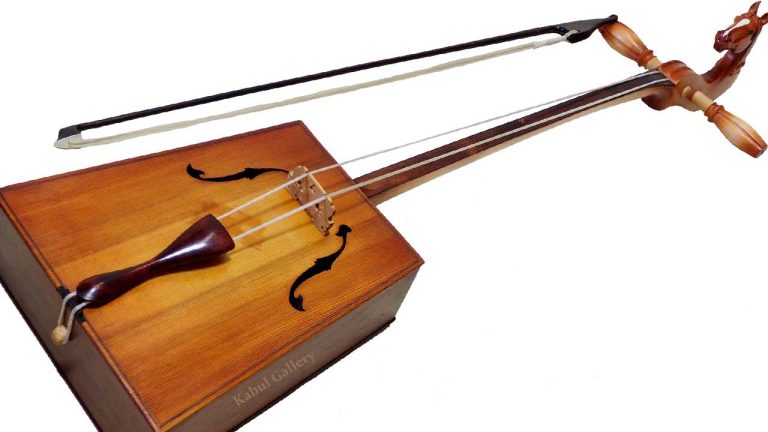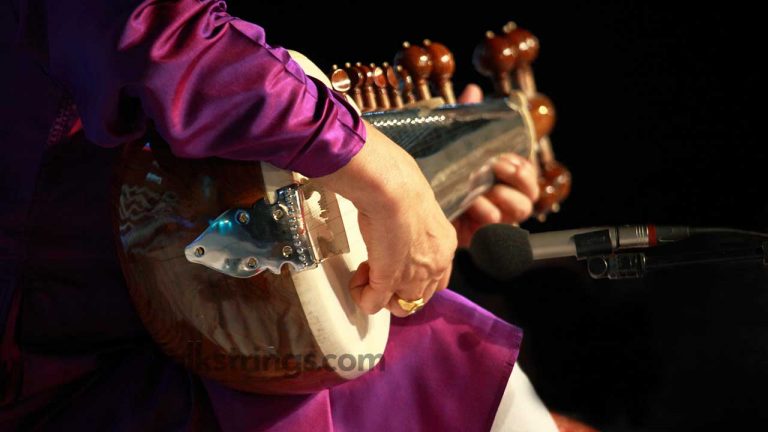Asian String Instruments: An Introduction to The Sounds and Styles
Folkstrings.com is reader-supported. When you buy through links on our site, we may earn a small commission.
Asian string instruments encompass a rich tapestry of musical tradition, each with unique characteristics that reflect the diversity of cultures throughout the continent.
From the meticulously crafted biwa of Japan to the melodious erhu of China, these instruments carry centuries of history in their strings.
The resonant qualities of wood, often high-Q species as found in Asian plucked instruments, are central to the production of their distinct sounds.

The construction and materials used in Asian string instruments are as varied as the instruments themselves, with craftsmanship that has evolved over generations to perfect the sound and durability of each piece.
Simultaneously, playing techniques have been refined to express a wide range of musicality, from the delicate nuances of court music to the robust sounds of folk traditions.
These instruments are not just tools for performance; they are also integral to the cultural identity and heritage of the regions from which they originate, continually being adapted and preserved through time.
Key Points
- Asian string instruments have unique sounds influenced by diverse cultural practices and innovative construction methods.
- Mastery of playing technique is a vital component of the instrument’s expression and musical contribution.
- These instruments are deeply rooted in the societies they come from and represent a melding of history, music, and craftsmanship.
Table of Contents
Types of Asian String Instruments
In exploring the rich tapestry of Asian string instruments, I’ll cover some unique members from the families of zithers, lutes, and bowed instruments that are central to the musical traditions of East Asia.
Zithers
Zithers are a type of string instrument that have a body with strings stretched across it; they can be plucked or struck. When I think about East Asian zithers, a few prominent examples come to mind:
- The Chinese guzheng, a long zither with a deep, resonant sound, often used in both solo and ensemble performances.
- The qin, also known as the guqin, a revered Chinese zither with seven strings.
- From Japan, the koto stands out with its thirteen strings, traditionally played using small picks on the fingers.
| — | — |
|---|---|
| Instrument | Origin |
| Guzheng | China |
| Qin | China |
| Koto | Japan |
Lutes
Lutes are string instruments with a neck and a deep round back enclosing a hollow cavity, typically with a sound hole or opening in the body. Some well-known Asian lutes include:
- The Chinese pipa, recognizable for its pear-shaped body and fretted neck.
- The unique Japanese shamisen, with its unmistakable twang, stemming from its three strings and the use of a plectrum.
- The Indian sitar, distinguished by its long neck and a gourd body, possessing sympathetic strings that provide its characteristic sound.
| Instrument | Origin |
|---|---|
| Pipa | China |
| Shamisen | Japan |
| Sitar | India |
Bowed Instruments
The bowed instrument family in Asia is diverse, with each instrument having a unique sound and playing technique:
- The erhu, sometimes referred to as the Chinese violin, has two strings and is played with a bow.
- The huqin family, to which the erhu belongs, includes various bowed instruments with a similar structure but different sizes and pitches.
- The Vietnamese dan bau is a monochord, or one-string instrument, which produces a hauntingly beautiful vibrato effect.
| Instrument | Origin |
|---|---|
| Erhu | China |
| Huqin | China |
| Dan Bau | Vietnam |
Materials and Construction
When I explore the construction of Asian string instruments, I focus on the meticulous selection of materials for strings, bodies, and other components. This selection greatly influences the tonal quality and playability of the instruments.
Strings
Traditionally, silk was commonly used for strings, offering a delicate and distinct sound. However, many modern Asian string instruments now opt for metal strings, particularly those made from steel or bronze, due to their durability and brighter tone. Some instruments may also utilize nylon or other synthetic materials.
Bodies
The body of an instrument largely determines its sound character. Wood is the primary material used, with bamboo and red sandalwood being popular choices due to their acoustic properties.
The soundboard, typically made from softer woods, vibrates to project the sound, whereas denser woods might be used for the fingerboard or bridge to support structural integrity. The resonating chamber, often a pear-shaped body or cylindrical, is carefully crafted for sound amplification.
Other Components
Other significant parts include the nut and tuning pegs, often carved from hardwoods for their rigidity.
The movable bridges allow for fine-tuning of pitches. For instruments like the erhu or sanxian, the use of python skin or snakeskin is traditional for the resonator, although synthetic skin options are increasingly common for ethical and maintenance reasons.
The tail of the instrument, typically made from silk or nylon cords, provides stability and additional aesthetic appeal.
Playing Techniques and Musicality
In exploring Asian string instruments, I’ve noticed that the nuances of playing techniques greatly influence their musicality. Each method, whether it be plucking, bowing, or striking, brings out a distinct character and timbre from the instruments.
Plucking and Strumming
When I pluck or strum the strings of Asian string instruments, I engage directly with the strings, either with my fingertips or with a plectrum. The pitch is determined by the string’s length, tension, and mass, as well as how it’s plucked or strummed.
Many instruments feature a pentatonic scale, which is attained through their specific tuning and sometimes the layout of frets.
- Plucked Instruments: Often use a pentatonic scale, creating a distinct sound palette.
- Example: Chinese guzheng, where a series of bridges and movable frets allow for precise pitch adjustments.
- Strumming Techniques: Can produce a rhythmically driven or a melodically flowing sound, depending on how the strings are stroked.
- Example: Japanese shamisen, often strummed with a large plectrum called a bachi, which offers a sharp attack and resonate decay.
Bowing
Bowing is a technique I find particularly expressive; it elicits sustained tones that can be manipulated for dynamics and expression. The tension and speed of the bowing and the point of contact with the string control the volume, timbre, and pitch nuances.
- Bowed Instruments: These can have a deeply evocative sound, rich in overtones.
- Example: The erhu, a Chinese fiddle, uses a bow strung between its two strings and is capable of a wide range of dynamics and tonal variation.
Striking
Using hammers or mallets to strike the strings can produce a percussive sound that is typically crisp and resonant.
I tune the strings to precise pitches, and the struck method has a unique appeal due to its combined melodic and rhythmic potential.
- Struck Instruments: Often linear in their layout, allowing for swift melodic runs and complex rhythmic patterns.
- Example: The yangqin, a Chinese hammered dulcimer, is struck with bamboo hammers, each nuance in the striking technique resulting in a different timbre.
Cultural Significance and Evolution
In exploring the rich tapestry of Asian string instruments, I’m particularly fascinated by how they’ve both shaped and been shaped by the historical and cultural dynamics of the regions. Their evolution from traditional forms into contemporary contexts illustrates an enduring legacy and adaptability.
Historical Context
Historically, Asian string instruments have played pivotal roles in various cultures. In China, the plucked zither, known as the guzheng, emerged during the Tang Dynasty and was essential in Chinese music. It’s not merely an instrument but a cultural emblem, often found in paintings and poetry, symbolizing the refinements of scholarly life.
Similarly, Japan has its own traditional stringed instruments, such as the koto, which is deeply interwoven with Japanese music and Northern court performances.
The Chinese violin, or erhu, carries two strings and is capable of conveying a broad emotional range, integral to both traditional and contemporary music.
In Vietnam, instruments like the dan bau reflect a heritage of storytelling and cultural expression. Moving further south, India’s rich string instrument tradition features the sitar and sarod, central to classical Indian music.
Okinawa has given the world the sanshin, a banjo-like instrument central to Okinawan music and an ancestor to the Japanese shamisen, illustrating the cultural exchange across regions.
Instruments like the sanshin highlight not only the diversity within Asian music but also the interconnectedness of Asian cultures, tracing roots across different regions and histories.
Modern Adaptations
In the realm of modern adaptations, the reach of Asian string instruments extends into genres like jazz and rock, reflecting their versatility and appeal.
Contemporary musicians are not only preserving traditional methods but also innovatively integrating these instruments into modern music contexts.
For instance, the use of erhu in a symphony orchestra or a jazz ensemble showcases the instrument’s ability to cross cultural and musical boundaries.
The guzheng has found its way into contemporary film scores and fusion genres, demonstrating its adaptability.
Noteworthy is the presence of the Okinawan sanshin in contemporary music, often heard in settings far removed from its traditional folk origins.
Even as these instruments are reborn in contemporary music, many musicians and listeners alike value the preservation of their traditional settings.
This blend of old and new helps keep the instruments relevant and highlights the influx of Asian influence in the wider musical world.
The traditional craftsmanship and playing techniques of these instruments continue to be taught and revered, ensuring a thread of continuity within the modern context.
Maintenance and Care
When it comes to maintaining Asian string instruments, I’m particularly attentive to the materials they’re made from, such as wood, bamboo, and silk, which demand care and precision.
Wooden and bamboo parts can be sensitive to changes in humidity and temperature, so I always suggest storing your instrument in a stable environment to prevent warping or cracking.
For strings, the traditional silk ones require delicacy. I regularly check for fraying and recommend replacing them before they break.
Nylon and steel strings are more durable, but I ensure they are kept at the right tension to maintain both the instrument’s tone and structural integrity.
Bow Care:
- Tighten the hair before playing; loosen it afterwards.
- Occasionally rosin the bow to keep the grip on strings.
- Keep bow hair clean; avoid touch with oily hands.
Body Maintenance:
- Wipe the body with a soft, dry cloth after playing to remove rosin dust and moisture.
- Avoid the use of harsh chemicals; these can damage the finish.
Bridge and Fret Care:
- Ensure the bridge is properly aligned; it directly affects the sound.
- Check the frets for any signs of wear and tear if your instrument has them; worn frets can lead to intonation problems.
Here’s a quick tip: Plastic parts, if any, such as tuning pegs or pickguards, typically require less maintenance but should still be kept clean to help your instrument look its best.
Remember: Regular maintenance extends the life of your instrument and ensures it always sounds beautiful. So, I take a little time after each session to give my instruments the care they deserve.
Craftsmanship and Instrument Makers
When I explore the rich tapestry of Asian string instruments, the dedication and skill of the luthiers—those craftsmen responsible for their creation—immediately stand out. These artisans often choose traditional materials like bamboo for the construction of the guzheng, which is renowned for its resonant sound.
I’ve learned that the ruan, a Chinese plucked string instrument, is a perfect example of meticulous craftsmanship. It often features a circular body covered with python skin, which contributes to its distinctive tone.
However, the luthiers’ tasks are extensive and intricate, ranging from selecting the right materials to the final assembly, ensuring each handmade piece is unique.
The creation of a sanxian, another traditional string instrument, reveals the meticulous handwork involved. Craftsmen fashion its long neck from wood, and the body is traditionally covered with snake skin, which affects the instrument’s acoustics.
Here’s a concise comparison between handmade and mass-produced instruments:
| Feature | Handmade | Mass-produced |
|---|---|---|
| Materials | Often high-quality, traditional (e.g., silk strings, bamboo) | May use synthetic materials for consistency |
| Sound Quality | Unique timbre due to individual crafting | More standardized but can lack character |
| Aesthetic | Each instrument has distinct visual qualities | Uniform appearance |
| Sustainability | Use of natural, sometimes locally-sourced materials | Production can prioritize efficiency over environmental considerations |
| Cultural Significance | Often made by craftsmen following traditional methods | May lack the cultural connection of handmade instruments |
The nuances of Asian string instruments are profoundly tied to the work of their makers, who often uphold generations of traditional methods. Their passion for creating and preserving the sonic legacy of their culture is what gives these instruments not just their form, but their very soul.
Frequently Asked Questions
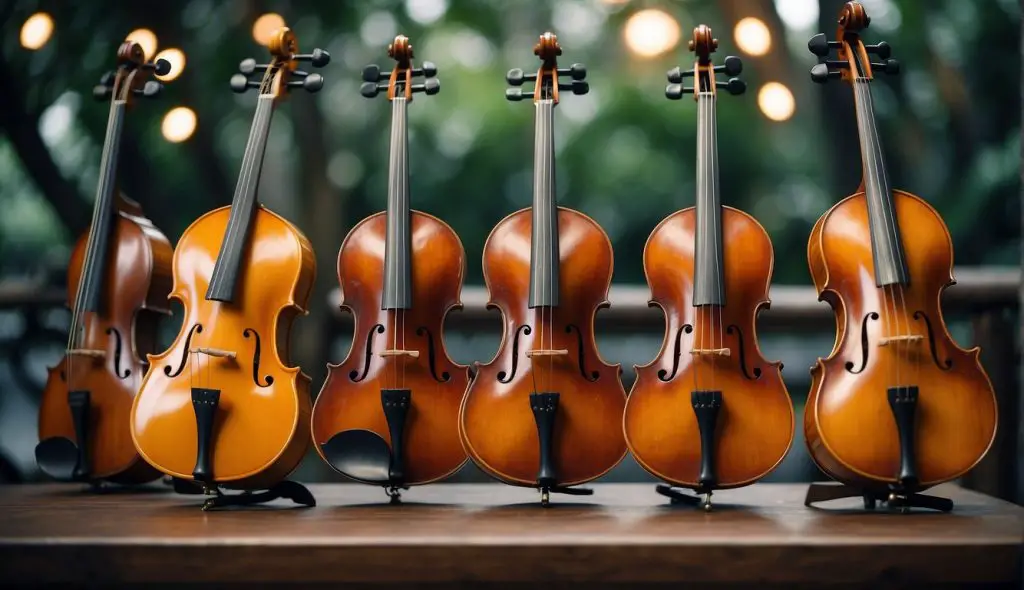
In this section, let’s explore some of the common curiosities about Asian string instruments, from traditional models to where they can be found.
Where might one purchase traditional Asian string instruments?
Traditional Asian string instruments can be purchased from specialty music stores that focus on world instruments, online marketplaces, or directly from the craftsmen who make them.
International shipping is often available for these unique instruments.
What is the Asian stringed instrument with the large soundbox often played in ensembles?
The guzheng, with its large soundbox, is commonly played in ensembles. This ancient Chinese instrument typically has 21 strings and bridges that can be moved to adjust the pitch.
What are some popular chordophones found in Asian music?
Popular chordophones in Asian music include the Japanese koto, which has 13 strings, the Indian sitar with its 18-21 strings, and the Korean gayageum, which can have anywhere between 12 to 21 strings.
How many strings does the typically Chinese instrument, the pipa, have?
The Chinese pipa typically has four strings. It is a pear-shaped lute and is also known for its ability to convey a wide emotional range.
What is the name of the traditional two-stringed Chinese instrument?
The Erhu is a traditional two-stringed Chinese instrument, known for its expressive sound, often compared to that of a human voice.
Author Profile
-
Daniel Johnstone is an English writer with a love for stringed instruments from around the world.
He shares his love for these instruments through his writing for folkstrings.com, a website dedicated to all things related to folk string music.
Daniel's passion for music started at a young age, and he has since become an accomplished musician, playing guitar, cavaco, and recently, the harp.
His dedication to learning and sharing his knowledge of stringed instruments is evident in his insightful and engaging blog posts. Whether you're a seasoned musician or a beginner, Daniel's writing is sure to inspire and entertain you.
When he's not playing music or writing, you can find Daniel exploring new instruments and seeking out new sounds to share with his readers.
Latest entries
 AutoharpApril 4, 2024What Is the Autoharp Made Of: Exploring Its Materials and Craftsmanship
AutoharpApril 4, 2024What Is the Autoharp Made Of: Exploring Its Materials and Craftsmanship AutoharpApril 4, 2024Is Autoharp Easy to Play? Unveiling the Truth for Beginners
AutoharpApril 4, 2024Is Autoharp Easy to Play? Unveiling the Truth for Beginners AutoharpApril 4, 2024What Is an Autoharp Worth? Your Guide to Pricing and Value
AutoharpApril 4, 2024What Is an Autoharp Worth? Your Guide to Pricing and Value AutoharpApril 4, 2024Are Autoharp and Zither the Same Thing? Unraveling String Instrument Myths
AutoharpApril 4, 2024Are Autoharp and Zither the Same Thing? Unraveling String Instrument Myths
Affiliates:
This post may contain affiliate links that at no additional cost to you, the site may earn a small commission. We only recommend products we would use ourselves and all opinions expressed on this site are our own.
Accuracy Advice:
While we strive to provide up-to-date and accurate information, the content in this article may not reflect the most current research or medical guidelines. We encourage readers to do further research and consult with professionals for more personalized advice.
Our Recommendations:
The products and services mentioned in any of our articles are recommended based on our independent research and personal experience. We are not sponsored by any company. We aim to suggest products and services we believe are of high quality and could be beneficial to our readers.


